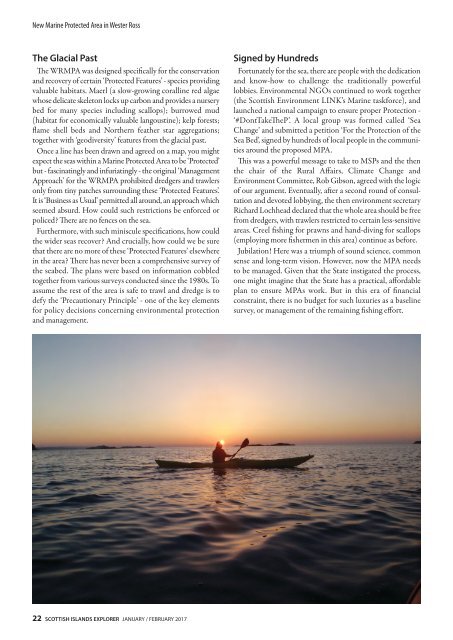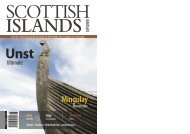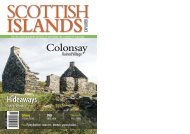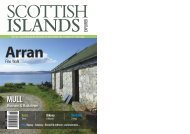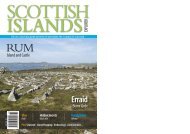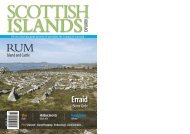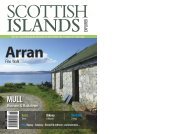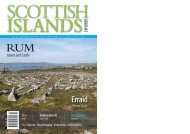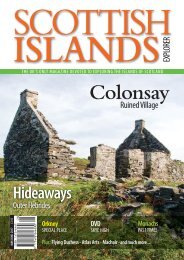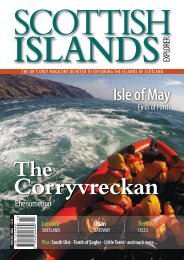Create successful ePaper yourself
Turn your PDF publications into a flip-book with our unique Google optimized e-Paper software.
New Marine Protected Area in Wester Ross<br />
The Glacial Past<br />
e WRMPA was designed specifically for the conservation<br />
and recovery of certain ‘Protected Features’ - species providing<br />
valuable habitats. Maerl (a slow-growing coralline red algae<br />
whose delicate skeleton locks up carbon and provides a nursery<br />
bed for many species including scallops); burrowed mud<br />
(habitat for economically valuable langoustine); kelp forests;<br />
flame shell beds and Northern feather star aggregations;<br />
together with ‘geodiversity’ features from the glacial past.<br />
Once a line has been drawn and agreed on a map, you might<br />
expect the seas within a Marine Protected Area to be ‘Protected’<br />
but - fascinatingly and infuriatingly - the original ‘Management<br />
Approach’ for the WRMPA prohibited dredgers and trawlers<br />
only from tiny patches surrounding these ‘Protected Features’.<br />
It is ‘Business as Usual’ permitted all around, an approach which<br />
seemed absurd. How could such restrictions be enforced or<br />
policed? ere are no fences on the sea.<br />
Furthermore, with such miniscule specifications, how could<br />
the wider seas recover? And crucially, how could we be sure<br />
that there are no more of these ‘Protected Features’ elsewhere<br />
in the area? ere has never been a comprehensive survey of<br />
the seabed. e plans were based on information cobbled<br />
together from various surveys conducted since the 1980s. To<br />
assume the rest of the area is safe to trawl and dredge is to<br />
defy the ‘Precautionary Principle’ - one of the key elements<br />
for policy decisions concerning environmental protection<br />
and management.<br />
Signed by Hundreds<br />
Fortunately for the sea, there are people with the dedication<br />
and know-how to challenge the traditionally powerful<br />
lobbies. Environmental NGOs continued to work together<br />
(the <strong>Scottish</strong> Environment LINK’s Marine taskforce), and<br />
launched a national campaign to ensure proper Protection -<br />
‘#DontTakeeP’. A local group was formed called ‘Sea<br />
Change’ and submitted a petition ‘For the Protection of the<br />
Sea Bed’, signed by hundreds of local people in the communities<br />
around the proposed MPA.<br />
is was a powerful message to take to MSPs and the then<br />
the chair of the Rural Affairs, Climate Change and<br />
Environment Committee, Rob Gibson, agreed with the logic<br />
of our argument. Eventually, aer a second round of consultation<br />
and devoted lobbying, the then environment secretary<br />
Richard Lochhead declared that the whole area should be free<br />
from dredgers, with trawlers restricted to certain less-sensitive<br />
areas. Creel fishing for prawns and hand-diving for scallops<br />
(employing more fishermen in this area) continue as before.<br />
Jubilation! Here was a triumph of sound science, common<br />
sense and long-term vision. However, now the MPA needs<br />
to be managed. Given that the State instigated the process,<br />
one might imagine that the State has a practical, affordable<br />
plan to ensure MPAs work. But in this era of financial<br />
constraint, there is no budget for such luxuries as a baseline<br />
survey, or management of the remaining fishing effort.<br />
22 SCOTTISH ISLANDS EXPLORER JANUARY / FEBRUARY <strong>2017</strong>


